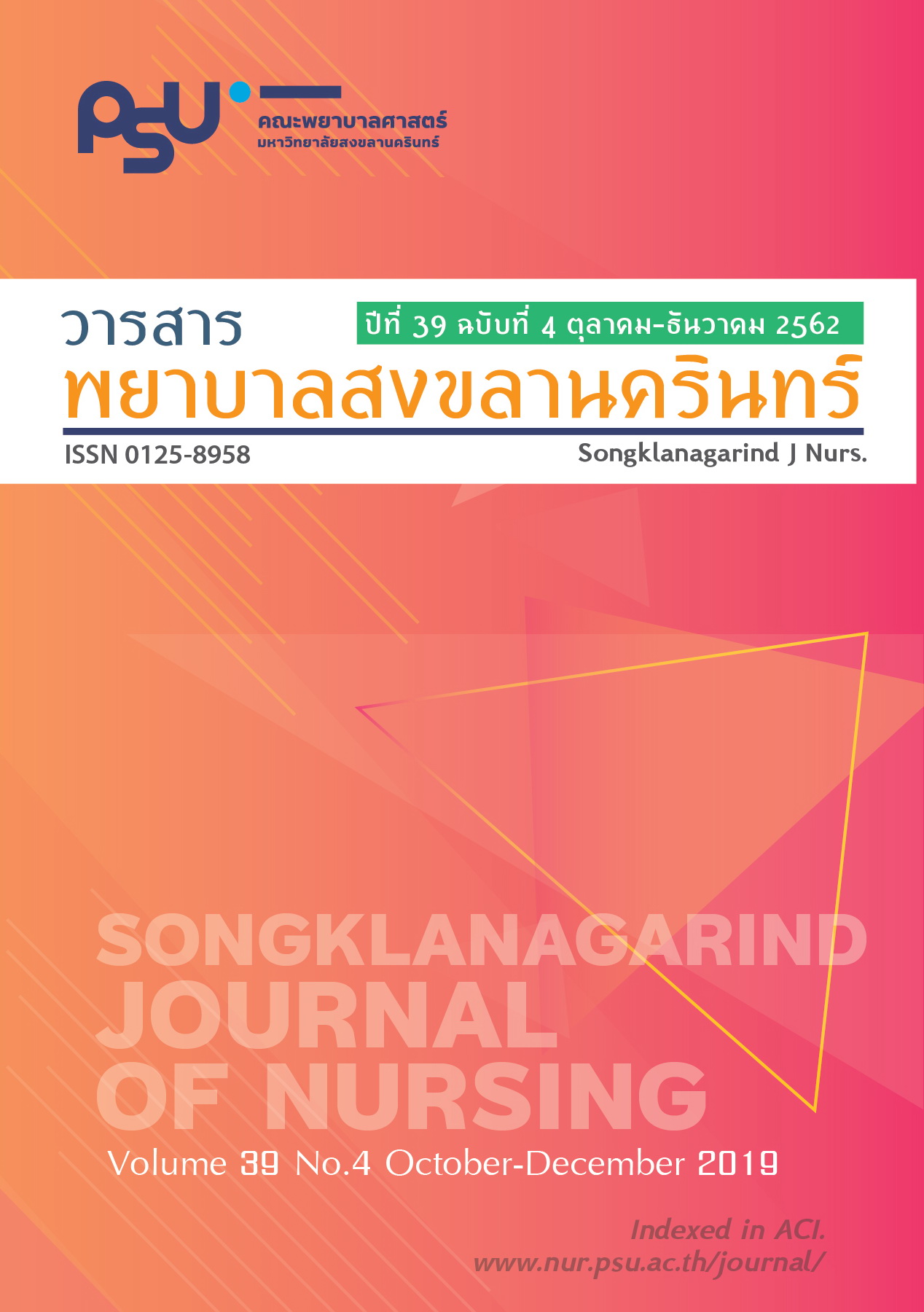Self-Management Experience of Adolescent Patients with Diabetic Mellitus
Main Article Content
Abstract
Adolescent patients with diabetes mellitus usually have a common problem with blood sugar control. This leads patients to learn adjust themselves. This research aimed to describe self-management experience of adolescent patients with diabetic mellitus in Phitsanulok Province by applying descriptive qualitative research. Nine participants who were 11-21 years old and diagnosis with T1DM or T2DM for 5 years. Data were collected by in-depth interview between June 2016 to May 2017.
The results showed that the adolescent patients with diabetic mellitus had four self-management experiences, namely: 1) self-management for themselves, including reduction of the severity and live longer and not depend on other family member; 2) seeking information about diabetes mellitus from two sources, including using technology and receiving knowledge from healthcare providers and people with diabetes mellitus; 3) Modifying self-management to control blood sugar, including diet control and herb trials and 4) learning to live with diabetes mellitus in 2 ways, including concerning when complications occurred and accepting that diabetes mellitus was one part of their life. The results of this study can be used as a basis for empowerment of adolescent patients with diabetic mellitus.
Article Details
References
Pediatric Nurses Association of Thailand. Diabetes mellitus in adolescent: Handout Conference 29 th Prediatric Nursing [Internet]. Thailand: Pediatric Nurses Association of Thailand: 2018 [cited 2018 Aug 12]. Avilable from: http://www.thaichildhealth.com/news. Thai.
Phitsanulok Provincial Health Office. Annual Report 2015. Phitsanulok: Phitsanulok Provincial Health Office; 2015. Thai.
Kotruchin P, Wanothayaroj E, Rattanachaiwong S, et al. Prevalence of impaired fasting glucose and type 2 diabetes in adolescence and young adults in rural Thailand. Srinagarind Med J. 2013; 28(2): 184-89. Thai.
Diabetes Association of Thailand under the Patronage of her Rayol Highness Maha Chakri Sirindhorn. Clinical practice guideline for diabetes. Pathum Thani: Romyen media; 2017. Thai.
Creer, L.T. Handbook of self-regulation. San Diego, CA: Academic Press; 2000.
Seephom S. Self-management in chronic kidney disease. TRCNJ. 2013; 6(1): 12-8. Thai.
American Diabetes Association. Children and adolescents standards of medical care in diabetesd. Diabetes Care 2016; 39(Suppl 1): S86–93.
Wisting, L , Bang, L, Skrinvanrhaug T, et al. Psychological barriers to optimal insulin therapy: More concerns in adolescent females than males. BMJ Open Diab Res Care. 2016; 23;4(1): 1-7. doi: 10.1136/bmjdrc-2016-000203.
Sangeam S, Sindhu, S. Diabetes mellitus in adolescent: The swinging of blood glucose. TJONC. 2000; 15(2): 66-80.
Plodpluang U. Data analysis in phenomenology studies. NJMPH. 2013;23(2): 1-10. Thai.
Lincoln Y S, Guba E G. Naturalistic inquiry. Beverly Hills. CA: SAGE; 1995.
Areemit R. Practical points in adolescent health care. Bangkok: A plus print; 2013. Thai.
Areemit R. Text book of adolescent medicine. Nuntabuli: Parbpim printing; 2017. Thai.
Wonganantnont P. Excessive internet usage behavioral in adolescents. JTRTAN. 2014; 15 (2): 173-8. Thai.
Keratiyutawong P & Hanuchalearnkul S. Follow up the effectiveness in self-management program in type 2 Diabetes mellitus patients. Rama Nurs J. 2010; 16(2):293-308. Thai.
Brorsson A L, Olinder A L, Viklund G, et al. Adolesecents’s perceptions of participation in group education using the Guided Self-Determination-Young method: A qualitative study. BMJ open Diab Res Care. 2017; 5(1): 1-8 e000432. doi:10.1136/bmjdrc-2017-000432.
Kanfer F. Helping people change: A text of method. 4 th ed. New York: Pergamon Press; 1988.
Creer T L. Handbook of Self regulation. San Diego: California Academic; 2000.
McSharry J, Moss-Morris R, Kendrick T. Illness perceptions and glycemic control in diabetes: A systematic review with meta-analysis. Diabet Med. 2011; 28:1300-10.


